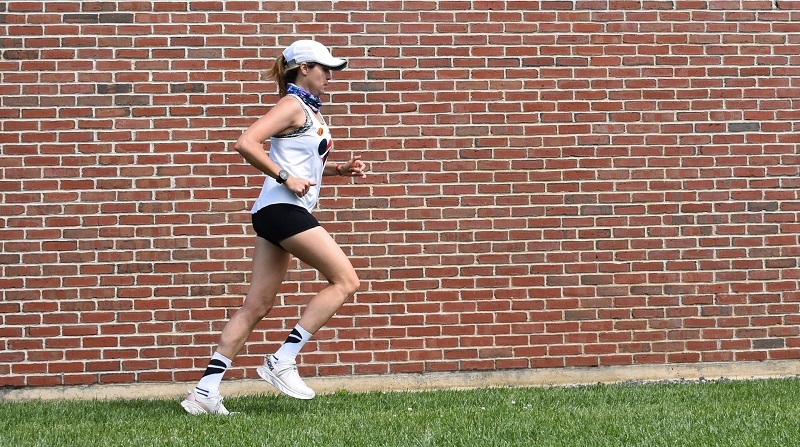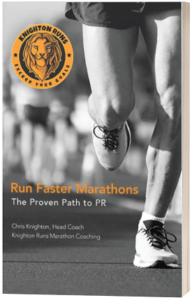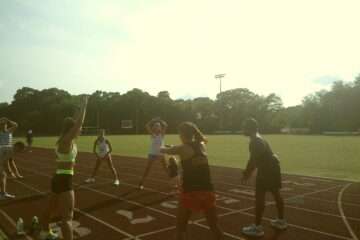How to improve your running form naturally
Incorporate these training techniques to run more efficiently
Author: Coach Chris Knighton

Disclosure: This article may contain affiliate links. When you buy through links on our site, I may earn an affiliate commission. As an Amazon Associate I earn from qualifying purchases.
Introduction
Do you run with good form? What is “good” running form anyway? In this article, we will dive into some of the most frequent questions I get asked as a running coach about improving your running form and dispel some of the myths out there about it.
The good news is that for distance runners your natural running form is probably the best one for you. Forcing changes into your form is in most cases not necessary. Instead, you can naturally improve your running form over time by incorporating training techniques and practices that promote “good form”.
Listen to The Podcast Version of This Article
We all run a little differently
Take a look at any group of runners going along and you will see all different types of running styles. Some run with faster cadence, while others run with less frequent steps. Some have bounding strides and high heel lifts in the back, while others seem more like they are shuffling along, barely lifting their legs off the ground.
Every runner is unique. There is no one “correct form” that is universal across all athletes. This is because the way you run as an individual is formulated over your entire lifetime of movement patterns.
Distance running is one of the simplest of all sports from a technical perspective. Success in running performance relies on aerobic strength, smart tactics, and listening to your body throughout training. Distance running does not rely nearly as much on technical excellence as it does in other sports such as sprint running or swimming. Therefore, discussions on running form for distance runners do not need to be overcomplicated.
Your best running form is the one that feels most natural and efficient to you.
Does foot strike matter?
Not as much as some would make you think.
The three types of foot strikes are heel strike, midfoot strike, and forefoot strike.
Heel striking has been villanized since the release of the fantastic book, Born to Run by Christopher McDougall. While I highly recommend this book for its entertainment value and great incites into little-known running cultures, the impact this book had was in many ways was unfortunate. The book inspired everyday Americans to ditch their normal running shoes in a misguided movement towards minimalist footwear and prompted many runners to forcibly change their running form away from heel striking. While using minimalist footwear and focusing on how you land each step can be a very good thing when done appropriately, many runners only found pain and suffering making a change like this too quickly.
Heel striking is the most common way for athletes to run at easy paces. It is natural that as you speed up you shift to a more midfoot strike. Once you reach top speeds you will naturally be forefoot striking.
Take a look at professional runners running in slow motion and you will see that many of them heel strike even at faster speeds. If it’s not slowing them down, it won’t slow you down either.
While midfoot striking is considered the “ideal” way to land for all but the fastest paces. How you land will vary greatly based on not just how fast you are running but also what kind of footwear you are wearing. The best runners vary the styles of footwear they are wearing depending on the goal of the run. Varying footwear ensures you are not landing in the same way every single step and therefore distributes the impact forces and conditioning benefits from running more evenly.
Does cadence matter?
In general, when you run slower you will have a slower cadence. When you run faster, you will have a faster cadence.
There is no magic cadence number you want to hit for all running paces or for any given pace. There is a myth that 180 steps per minute is the ideal cadence for all speeds. This is simply not true.
The myth of 180 being the magic number is a misrepresentation of an observation that in a specific professional race all of the racers ran 180 spm. The problem is, they were going at a very fast speed in this race. When these professional runners go for easy jogs they certainly aren’t running 180 spm.
Cadence is also affected by our individual heights. Shorter runners have faster cadence typically for the same speed. This is because due to their shorter legs they need to take more steps per minute than a taller longer-legged runner to go the same speed.
Don’t focus on your specific steps per minute rate. Instead, focus on running with quick and light steps rather than long and bounding strides. When a coach tells you to run “slow” or run “easy,” you may find it more helpful to think of running “lightly”. Run like you are running on ice or shells you don’t want to crush. Keep your arms moving quickly and your legs will follow. Often these tricks help keep your cadence quick and light when you are tiring.
Should I intentionally change my running form?
In general, no. Do not force change in your movement patterns.
Your form is the result of your lifetime of growth, injury, and movement. The way you move best is unique to you. Run how feels natural to you and feels most efficient. That may look very different than others and that is okay.
Purposely changing your form typically results in a decrease in your running efficiency. When you change one aspect of your form “for the better” you are likely in turn being less efficient in another area because the change you are trying to implement will not “feel natural.”
Don’t make changes just for the sake of changes, unless something stands out as noticeably bad.
Do friends point out odd things with your running style? Those may be worth a closer look, but they also may be totally fine for you. Remember you are a unique human with unique anatomy.
Have you repeatedly been injured from running? As a coach, I would assert your running form is likely not the reason for the injury. I believe most injuries come from doing too hard of training, too fast, and with inadequate rest, recovery, and poor nutrition. But form can play a factor as well so it’s not something to rule out right away.
How to naturally improve your running form
The best way to improve your form as a distance runner is through natural adoption of better form over time.
Do these things…
Run more frequently and with less fatigue
Gradually increase your number of days per week spent running and your total weekly mileage. Your body will naturally find its best running form as you run more frequently.
Perform warm-up drills at least once a week
Practicing warm-up drills which isolate one aspect of running form, such as high-knees and butt kicks, will improve your muscle memory for running with a more efficient form.
Regularly perform speed work and strides
Running faster paces encourages us to run with better, more economical form. Running fast gets you on your mid-foot and fore-foot as you run. It makes you run with a faster cadence. To run workouts well and push yourself to your limit you must run with your best form. When you regularly perform speed work the benefits to your form will extend beyond just the workout and you’ll incorporate the positive form changes in your everyday easy and long runs as well.
Run hills, especially uphill
Running up and down hills forces you to recruit different muscles and movement patterns on your run, thereby making you a stronger and more resilient runner. Running uphill specifically helps improve running form because it encourages you to run more on your mid to forefoot, drive your arms, and maintain a tall posture.
Incorporate core and upper body strength
Incorporating strength exercises into your weekly routine will give you the muscular endurance to maintain good running form even in the later stages of races and long runs when you are getting tired.
Avoid these things…
Avoid carrying things when you run that will cause an uneven weight distribution on your body and thereby force you to make subtle adjustments to your form.
Unless absolutely necessary, avoid wearing cell-phone holder armbands, running with your phone in your hand, and running with water bottles in your hands. Running backpacks and vests should also be avoided as much as possible.
While carrying these things is often necessary on easy runs, you should leave them at home and try to run unencumbered during fast workouts or long runs.
An exception would be for ultra-runners who plan to carry gear with them during their event. In this case, it is good to train with your gear on.
Form cues to remember
As you tire over a challenging run or race, it is natural for your form to degrade. Often it is those who are best able to keep running with efficient form who are triumphant in the finish of their race.
Here are cues to remember when you notice your form getting sloppy. These are also good cues to recall when practicing strides and other form drills.
Head
Keep it level and looking forward. Relax your face and lower lip. Smile a bit when it gets hard. This will help you breathe better.
Shoulders
Keep them relaxed and over your hips. Your back should be straight up and down, not hunched forward or back. Think “run tall.”
Pelvis
Try to keep your pelvis upright and in line with your back and shoulders. This will help you lift your knees higher and more powerfully as you run. Again, think “run tall.” Don’t tip forward or backward.
Hands
Keep them loose. Pretend you are holding potato chips between your fingers that you don’t want to crush.
Arms
Swing lightly at a 90-degree angle at your sides. Keep them relaxed and moving quickly. Your leg speed matches your arm speed. You can often speed up by pumping your arms faster.
Feet
Try to land with your feet under your body. Don’t over-extend your feet. Think “quick and light steps” instead of “long and bounding strides.”
Summary
Runners will best improve their running form by naturally adopting more economical ways of running over time. This adoption comes gradually as runners incorporate techniques into their training that promotes running with good form.
Forcing changes in your running form is not the correct approach because it will likely lead to less efficient running or worse yet, injury.
Incorporate the training techniques outlined in this article and remember the form cues listed above whenever you notice your running form getting sloppy. Recall them also when you are performing form drills such as strides or hill-sprints to get the most benefit from your hard work.
Continue the conversation in the comments below
What techniques do you employ to run with better form? What questions do you have about improving your form?



